This is an event recap. Jump to the end of the article to watch the replay
Infrastructure across California needs repair; water and wastewater alone need 50 billion dollars in funding to maintain basic functioning. California also needs to build 3.5 million homes in the next 10 years. These two issues are directly related. Affordable housing development where water infrastructure is in the worst condition is likely the place where new housing is least likely to “pencil out.”
Last year, BIG and PRE Collective conducted research that confirmed this pressing issue. We hosted a conversation to bring attention to this barrier and the untapped potential we see in how funding can be deployed. We recognize the pivotal role developers, public officials, and funders have in supporting place-based, community-led, and community-centered pilots to address this challenge.
These new approaches aim to leverage federal water infrastructure funding to improve existing infrastructure conditions in disinvested areas and enable the construction of new affordable infill housing. In addition, BIG and PRE Collective want to set a north star on how cities can pre-develop around expected and current infrastructure needs so that vital housing development can happen without putting the burden on individual businesses and affordable housing developers.
Aysha Pamukçu, Policy Fund Director at the San Francisco Foundation and one of Build It Green’s Founding Sponsors, opened the conversation by sharing the three opportunities she sees in these interwoven issues, acknowledging they can feel intimidating but shouldn’t make us feel stuck.
Shalini Vajjhala, of PRE Collective and our partner host, moderated the conversation. She emphasized that we often try to solve problems by breaking them into component parts and addressing each small piece of the problem separately. However, our housing and infrastructure challenges are a different kind of problem. Shalini pointed out that if we, “ zoom out to make the problem bigger, and in that way find and address root causes with collaboration, we can use innovation and coordination to greater benefit and public good.” She grounded us in the unique opportunities of this moment — historic funding and historical levels of attention on especially water and sewer infrastructure, in addition to pressing housing needs.
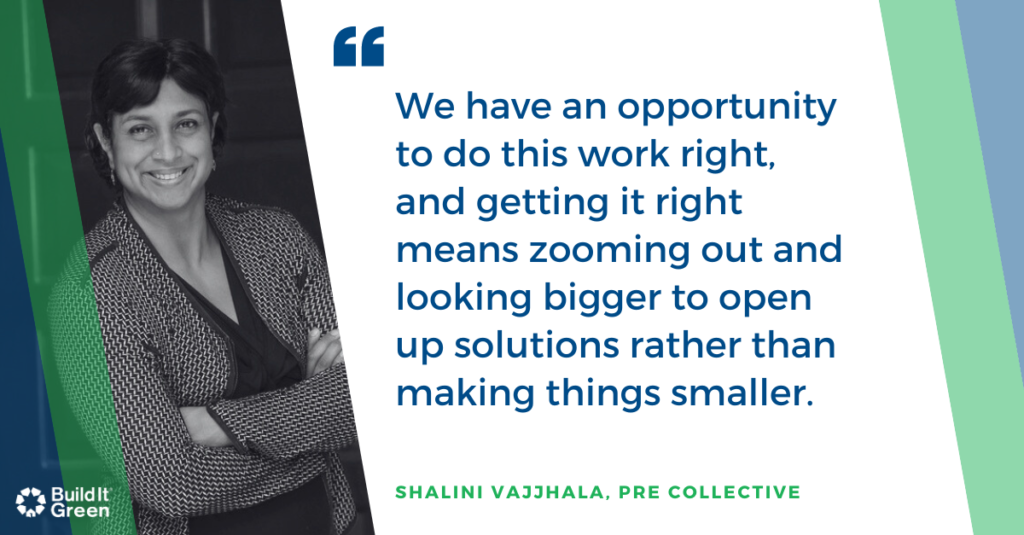
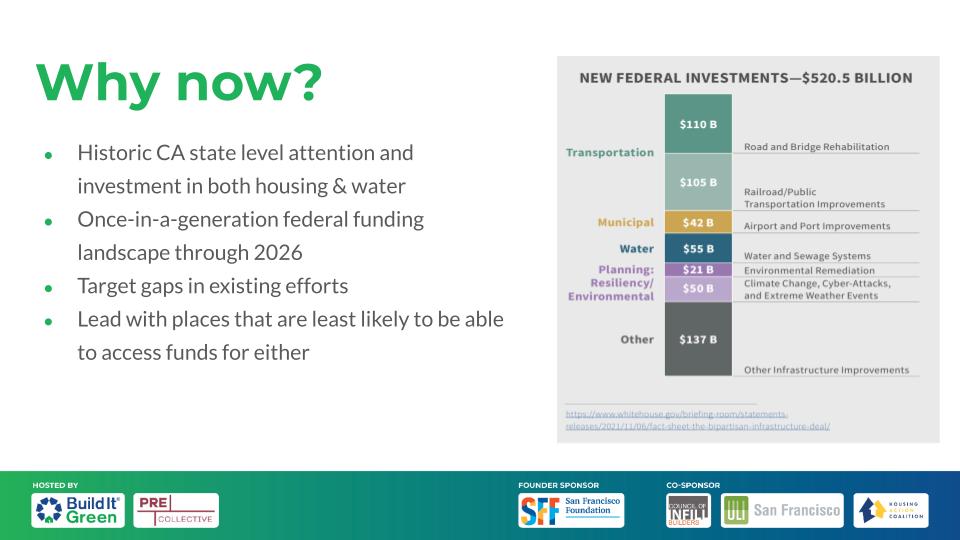
New federal investment dollars of over $500 billion dollars are newly available to local communities, who could take advantage of this funding to enable critically needed infill housing development.
Our speakers included:
Meea walked us through a brief history of funding sources for infrastructure development serving infill housing. Decades ago, California had programs that incentivized redevelopment and infill housing, in great opportunity areas with access to transit and many amenities. Redevelopment Agencies began in 1945 and were the norm; and they funded a lot of infill-serving infrastructure — often areas that were low-income, disinvested, and home to many people of color. There were many public-private partnerships that drove this redevelopment. In 2012, redevelopment agencies ceased to exist in California, resulting in a billion dollars of investment through these agencies disappearing.
In 1978, Proposition 13 was passed, allowing homeowners to have predictable property taxes. However, local governments realized that housing would no longer provide the tax basis needed to upkeep infrastructure in the current model. As a result, many places began disincentivizing building housing and encouraging business and commercial development because it provided more favorable tax conditions.This further worsened the housing crisis and negatively impacted infrastructure upkeep and development.
We’re now missing financing tools for infrastructure development in our existing communities. The first development projects in existing neighborhoods with degraded or missing infrastructure carry the majority of costs of building the necessary elements to serve the new housing project. New developments can utilize the Mello-Roos tax, an ad hoc California tax district created to finance local infrastructure projects meant to bypass Prop 13 restrictions, but similar funding mechanisms are currently missing for infill housing development. These projects are so important for our housing, climate and equity goals, but we’ve made it increasingly difficult to fund them.
Justin shared an example of a development he’s working on that’s under construction in Berkeley, that’s working to play a part in addressing inequities — 100% permanently affordable homeownership-focused project with big environmental goals and a public subsidy. It’s urban infill, on Shattuck avenue, great transit access, in the path of progress. It’s a very sustainable-forward project, boasting mass-timber CLT, enhanced passive haus, all electric with battery back-up and solar PV, and water recycling systems from Sweden. While it hasn’t been limited by infrastructure development because of its location and Berkeley’s preparation for this work, it’s addressing other intersectional challenges like historic barriers to wealth building via home-ownership. As Justin pointed out, even without the infrastructure limits, it’s been a real challenge to bring all these pieces together (affordability, sustainability, etc), and the work has benefited from major and diverse collaborators.
Meea shared an example of a project at 429 12th Street in Sacramento called La Valentina, which became an award-winning project. It was a gas station owned by the redevelopment agency for 25 years in the Alkali Flat neighborhood. There had already been three failed attempts to develop the site. They had to do a ton of infrastructure preparatory work, including putting major transformers underneath a significant train line, which changed the transit patterns and created opportunities for walkability. They had to get about 20 special permits and variances to change most of the zoning limits, numerous hearings, and many upset neighbors to navigate the land planning challenges to allow an infill housing development.
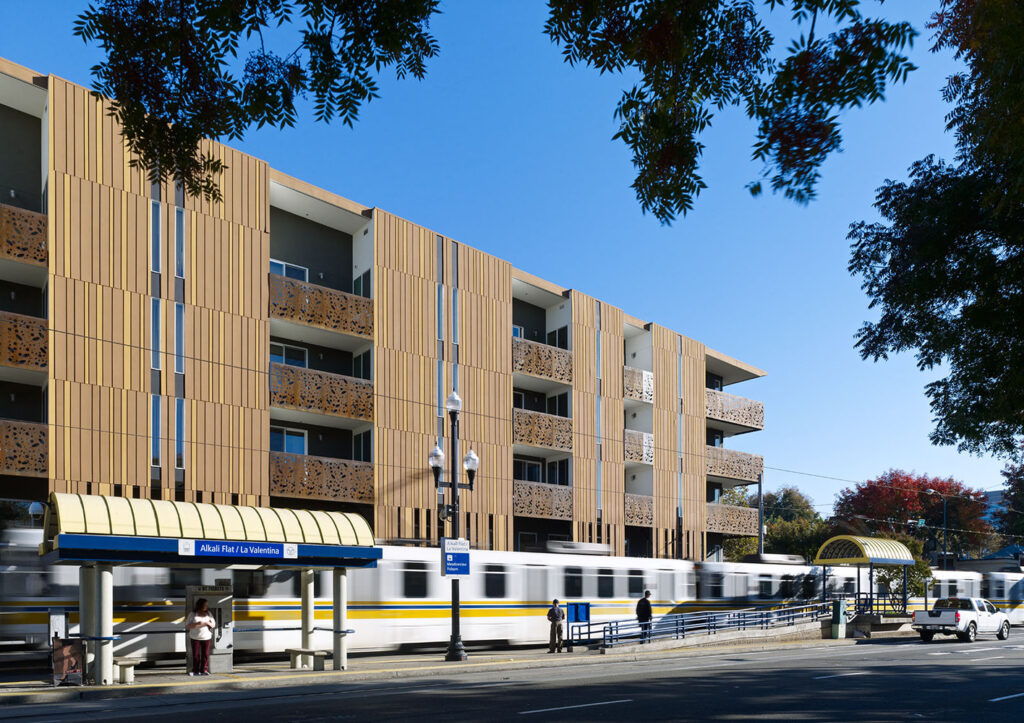
429 12th Street, Sacramento, CA 95814, United States
"The kind of project where everyone came together. When problems are big, you need to bring everyone to the table, bring partners to the table, and when that happens, you can solve big things"
Meea Kang Tweet
There are failures of market conditions for housing, and also failures of enabling conditions — planning failures. Reducing unknowns, the planning to do this takes real upfront thought, to help developers succeed in places where we want to see communities thrive. Tom Pace, the Planning Director, shared some of the work the City of Sacramento has done in this regard.
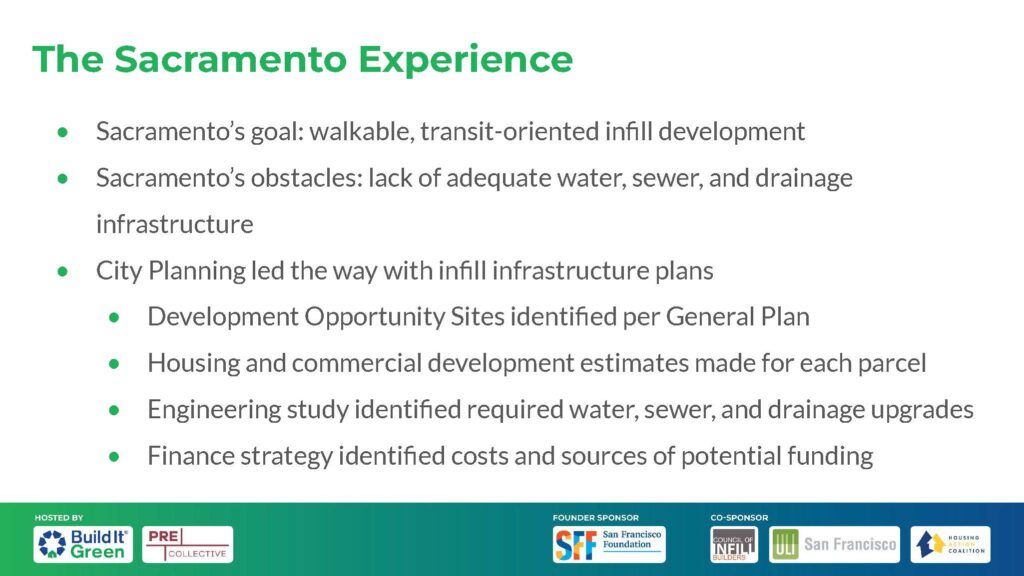
Tom Pace shared the City of Sacramento planning goals and proactive infrastructure development work.
He shared that even with perfect zoning and an easy permit process, it can still be hard to get a project built without the necessary water, sewer, and other infrastructure. Many older areas of Sacramento have long been targeted for infill development by the city, but not much has happened there for decades, indicating challenges in realizing those good intentions.
They realized one barrier is infrastructure. Believe it or not, not much is known about the state of the infrastructure in many of these areas, even by the utilities operating them. Sacramento public officials realized they’d put conditions on developers to understand the state of the existing system, then require them to do a study to do that, then plan and design for any needed new or improved infrastructure, then build it and upgrade it. This process led to many unknowns, both for costs and timelines, and that meant too much uncertainty for developers, which is a real barrier to infill development.
So, to address this concern, Sacramento started conducting proactive infrastructure studies. They hired engineers who could assess the current needs for infrastructure more holistically rather than project by project and then create an infrastructure plan based on that broader assessment.
They’ve then started to identify funding mechanisms and sources. For example, the Sacramento Area Council of Governments (SACOG) has a new pilot program called “Green Means Go,” which will support water and sewer development and is getting funding from the state. This program will identify green zones for infill development and identify projects to support development in those areas. The City of Sacramento is hoping to soon receive millions of dollars of funding identified through the REAP 2.0 program to do three key projects, with a total of $12M, which would enable 3,500 housing units.
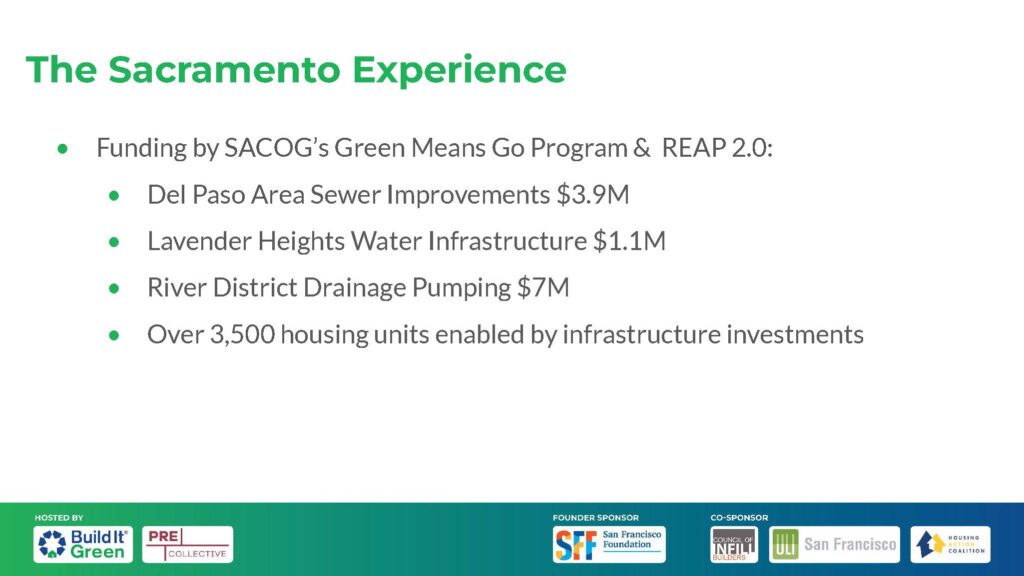
Several examples of existing funding proposals in Sacramento shared by Tom Pace, illustrating how the city is creating a proactive, planned approach to take advantage of infrastructure funding to support needed housing development.
"Let’s get organized and get smart about it! This funding is only available for multi-benefit projects! Let’s think about what we’re trying to build, and for whom, and remove those structural barriers to really solve the problems that are worth solving.”
Shalini Vajjhala Tweet
In her opening, Aysha shared a quote from a talk delivered at Harvard University for Black History Month in 1982 by Audre Lorde, who said “There is no such thing as a single-issue struggle because we do not live single-issue lives.” She was speaking from a civil rights context broadly, but it applies just as much today and on housing issues. Build It Green will continue to work with our partners to create spaces and resources that allow us to address our complex housing and building challenges, working collaboratively to bring our many individual strengths to bear, together, regeneratively.
Reach out to Cerena Harrison, [email protected], if you have any questions about this conversation or our ongoing Enabling Equitable Infrastructure program.
Most Californians would agree that there are better ways to build homes and develop and maintain our communities. Build It Green (BIG) believes that regenerative communities—which are not extractive, go beyond sustainability, and build potential for adaptation and resilience—are the way forward so that everyone can live in a place that’s affordable, equitable, and healthy.
In our first two decades, via our GreenPoint rated system and other programs, BIG worked with builders to normalize green homes throughout California. After a successful history focused on individual homes, BIG expanded our focus to transforming communities as a whole. That’s why today we connect and inspire changemakers— like developers, community advocates, nonprofits, government officials, and more—from all over the state to break down silos, form new partnerships, and come up with innovative approaches to our communities and homes that don’t compromise on the things that matter most.
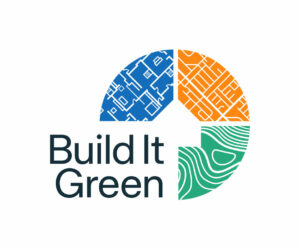

Alex Coba
Communication Associate
As a proud California native from Stockton, Alex brings a wealth of experience and a versatile skill set. He has a solid communication background with a Bachelor of Arts in Journalism and Public Relations from California State University, Chico. Alex is adept at strategic communications and media relations, with experience gathering and sharing stories from his local communities that uplift the unique spirit and values of those places. He is excited to join Build It Green, where he can apply his talents to further BIG’s mission to help communities across California thrive